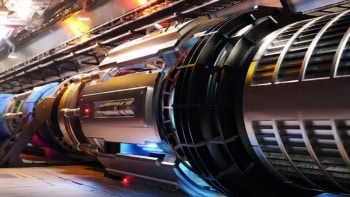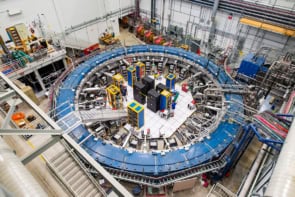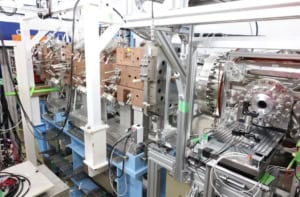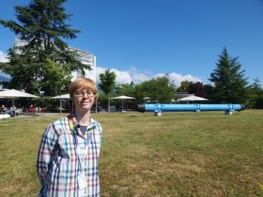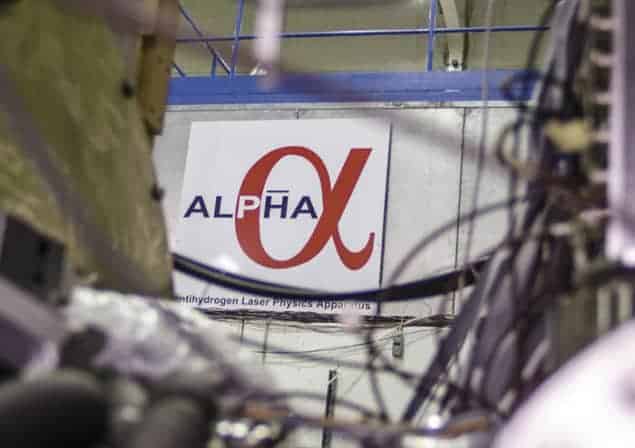
Physicists have taken another step forward in the search for signs that antimatter behaves differently to matter — and so might explain why the universe appears to consist almost exclusively of the latter. Researchers at the CERN particle-physics laboratory in Switzerland used laser spectroscopy to scrutinize the fine structure of antihydrogen, revealing with an uncertainty of a few percent that the tiny difference in energy of states – known as the Lamb shift – is the same as it is in normal hydrogen.
The fact that the cosmos seems to contain very little antimatter – even though equal quantities of that and ordinary matter should have been produced following the Big Bang – is a major outstanding problem in physics. Generating, trapping and then measuring atoms of antimatter offers a relatively new way of probing this asymmetry. In particular, anomalies in the spectra of antiatoms compared with the known results from ordinary matter could point to a violation of what is known as charge–parity–time (CPT) symmetry.
The ALPHA collaboration at CERN is led by Jeffrey Hangst of Aarhus University in Denmark and is one of the leading groups in the field. It makes atoms of antihydrogen by taking antiprotons from the lab’s Antiproton Decelerator and combining them inside an electromagnetic trap with positrons emitted by a source of radioactive sodium. To be able to study the resulting neutral atoms over extended periods it stores them at the local minimum of a magnetic field created by powerful superconducting magnets, thanks to the interaction of that field with the particles’ tiny magnetic dipole moments.
The ALPHA Collaboration has achieved spectacular progress
Randolf Pohl
ALPHA uses laser beams tuned across a specific range of frequencies to study the energy spectrum of antihydrogen. It has already measured the energy difference between the ground and first excited states (1S and 2S), showing in 2018 that the difference is equal to that of normal hydrogen at a level of one part in 1012. That uncertainty was within three orders of magnitude of the best hydrogen measurements and about five below the level that a theory known as the Standard-Model Extension predicts could reveal CPT-violating effects.
Precision studies
In the latest research, reported in Nature, ALPHA has instead probed fine structure within antihydrogen’s first excited state. It did so by accumulating several hundred cold anti atoms – produced in groups of about 20 every four minutes – and storing these atoms for over two days using a magnetic-field of 1 T. It then used short pulses of ultraviolet light to lift the atoms from their ground state to either the 2P1/2 or 2P3/2 states. As the atoms dropped back down to the 1S state, some (in specific magnetic substates) could no longer be held by the magnetic trap and so annihilated with atoms of ordinary matter in the trap walls.
By identifying peaks in a plot of the number of annihilations against laser frequency, Hangst and co-workers were able to establish the energy gaps between the two 2P states and the 1S state in the presence of the magnetic field. These results had a precision of 16 parts in a billion. Then subtracting the smaller gap from the bigger one, and using theory to work out what the difference would be without a magnetic field, they found that the so-called fine-structure splitting in antihydrogen is equal to that of its matter counterpart to within 2%.
Finally, the researchers subtracted the 1S to 2P1/2 energy from their previously obtained figure for the 1S–2S transition to yield a value for the Lamb shift (the gap between the 2S1/2 and 2P1/2 states). Discovered by Willis Lamb in 1947, this effect arises from the interaction of hydrogen’s electron with quantum fluctuations in the vacuum and was key to the subsequent development of quantum electrodynamics. ALPHA has shown that the Lamb shift in antihydrogen agrees with that of normal hydrogen to about one part in ten. ALPHA confirms antihydrogen is neutral as charged
Writing a commentary to accompany the research, Randolf Pohl at the University of Mainz in Germany says that the ALPHA Collaboration “has achieved spectacular progress” in precision spectroscopy of antihydrogen. Such research, he argues, could in future enable tests of CPT symmetry, quantum electrodynamics and the Standard Model of particle physics.
In particular, Pohl explains that reducing uncertainty in measurement of the Lamb shift to less than one part in 10,000 would allow scientists to demonstrate that the antiproton has a finite charge radius, like the proton. Pushing the uncertainty down even further, he told Physics World, “may eventually help establish CPT violation, if it exists in nature”.
